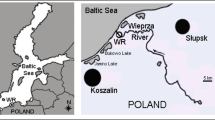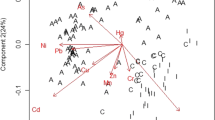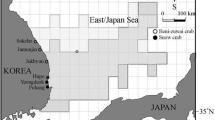Abstract
The concentrations of Pb, Cd, Zn, Cu, Ni, Cr, Mn, Co, As, and Se were determined in the abdominal muscle and hepatopancreas from raw and cooked crayfish of Astacus astacus (L.) and Pacifastacus leniusculus (Dana), both of Swedish origin. After cooking, the concentrations of Cd, Ni, and Co in the hepatopancreas showed a decrease and the concentrations of Pb, Cu, and Mn in the abdominal muscle showed an increase. Metal and metalloid concentrations were also determined in the abdominal muscle and hepatopancreas of commercially caught and cooked crayfish, including Astacus leptodactylus (Esch.) and Procambarus clarkii (Girard), from China, Spain, Sweden, Turkey, and USA. Most of the elements showed little variation except for cadmium in the abdominal muscle of P. leniusculus from California, which was markedly higher (mean=0.082 mg/kg) than the others (mean=0.004 mg/kg). Metal and metalloid concentrations in hepatopancreas varied greatly within as well as between countries. In the hepatopancreas from P. leniusculus from a Swedish lake the manganese concentrations were markedly higher than in any other crayfish. The intake of cadmium from crayfish inhabiting uncontaminated waters will be low if the hepatopancreas is not consumed.
Similar content being viewed by others
References
Alikhan MA, Bagatto G, Shaheen Z (1990) The crayfish as a “biological indicator” of aquatic contamination by heavy metals. Water Res 24:1069–1076
Bagatto G, Alikhan MA (1987) Copper, cadmium and nickel accumulation in crayfish populations near copper-nickel smelters at Sudbury, Ontario, Canada. Bull Environ Contam Toxicol 38:540–545
Diaz-Mayans J, Hernandez F, Medina J, Del Ramo J, Torreblanca A (1986) Cadmium accumulation in the crayfish, Procambarus clarkii, using graphite furnace atomic absorption spectroscopy. Bull Environ Contam Toxicol 37:722–729
Finerty MW, Madden JD, Feagley SE, Grodner RM (1990) Effect of environs and seasonality on metal residues in tissues of wild and pond-raised crayfish in southern Louisiana. Arch Environ Contam Toxicol 19:94–100
IAEA (1980). Intercalibration of analytical methods on marine environmental samples. Trace element measurements on fish-flesh sample (MA-A-2) (Supplement). Progress Report No. 18. International Laboratory of Marine Radioactivity, IAEA, Musée Océanographique, Monaco
Jorhem L, Sundström B, Åstrand B, Haegglund G (1989) The levels of zinc, copper, manganese, selenium, chromium, nickel, cobalt, and aluminum in the meat, liver and kidney of swedish pigs and cattle. Z Lebensm Unters Forsch 188:39–44
Jorhem L, Slorach S, Sundström B, Ohlin B (1991) Lead, cadmium, arsenic, and mercury in meat, liver and kidney of swedish pigs and cattle. Food Add Contam 8:201–212
Jorhem L (1993) Determination of metals in foodstuffs by atomic absorption spectrophotometry after dry ashing: An NMKL collaborative study of lead, cadmium, zinc, copper, iron, chromium, and nickel. J Assoc Offic Anal Chem 76:798–813
Keenan S, Alikhan MA (1991) Comparative study of cadmium and lead accumulations in Cambarus bartoni (Fab.) (Decapoda, Crustacea) from an acidic and a neutral lake. Bull Environ Contam Toxicol 47:91–96
Luoma NS, Dagovitz R, Axtmann E (1990) Temporally intensive study of trace metals in sediments and bivalves from a large river-estuarine system: Suisun Bay/delta in San Francisco Bay. Sci Tot Environ 97/98:685–712
Madigosky SR, Alvarez-Hernandez X, Glass J (1991) Lead, cadmium and aluminum accumulation in the red swamp crayfish Procambarus clarkii G. collected from roadside drainage ditches in Louisiana. Arch Environ Contam Toxicol 20:253–258
Rincon-Leon F, Zuera-Cosano G, Pozo-Lora R (1988) Lead and cadmium concentrations in red crayfish (Procambarus clarkii, G.) in the Guadalquivir river marshes (Spain). Arch Environ Contam Toxicol 17:251–256
Vahter M, Berglund M, Friberg L, Jorhem L, Lind B, Slorach S, Åkesson A (1990) Dietary intake of lead and cadmium in Sweden. V»r Föda 42, Supplement 2
Waaler T (1993) Letter regarding trace metals in IAEA reference material MA-A-2 from the Norwegian Food Control Authority. Swedish National Food Administration reg. no. 1200/93
Zanella EF (1982). Shifts in cadissfly species composition in Sacramento River invertebrate communities in the presence of heavy metal contamination. Bull Environ Contam Toxicol 29:306–312
Author information
Authors and Affiliations
Rights and permissions
About this article
Cite this article
Jorhem, L., Engman, J., Sundström, B. et al. Trace elements in crayfish: Regional differences and changes induced by cooking. Arch. Environ. Contam. Toxicol. 26, 137–142 (1994). https://doi.org/10.1007/BF00224796
Received:
Revised:
Issue Date:
DOI: https://doi.org/10.1007/BF00224796




